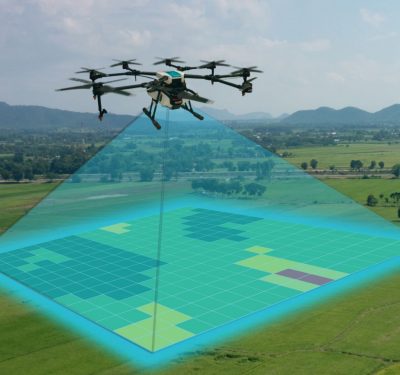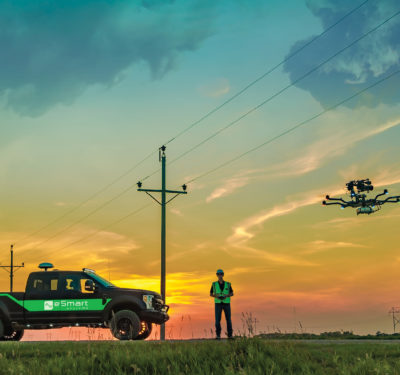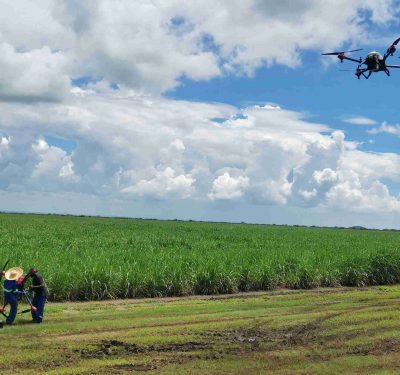
A new electric drone, the US-1, can fly for two hours on a single charge—a flight time comparable with gasoline-fueled systems. In contrast, a typical battery-powered quadcopter can fly up to about 30 minutes on one charge.
With the launch of its US-1 drone the firm Impossible Aerospace of Sunnyvale, California vaulted out of stealth mode. The unmanned aircraft is the result of years of development from motor and battery experts formerly from, among others, Tesla Motors and SpaceX.
“We are very excited to unveil the US-1 to the public as our first product,” said Spencer Gore, founder and CEO of Impossible.
The new drone is a quadcopter that is about 26 inches long and 26 inches wide, with an unladen mass of 15.7 lbs. It can fly at speeds of more than 42 miles per hour, reaching more than 46.6 miles before recharging.
The US-1 relies on lithium-ion batteries that can charge up to 80 percent in 40 minutes. The secret of the US-1’s endurance is the batteries form part of the US-1’s airframe. “A lot of drone companies look at their vehicles and say, ‘The biggest, bulkiest part is the battery, so how can we carry less of that,’” Gore said. “We looked the other way—no matter what, the battery is going to be heavy, so we just really thought about how we could make this bulk as useful as possible.”
“Not much (of what) you are looking at is not battery with the US-1,” Gore said.
Gore began researching electric aircraft due to his experience working on electric cars at Tesla Motors. “A big problem the drone industry faces is that it promised that the future of drones was to fly beyond the line of sight, but the battery life of these systems is so poor that this is not really possible,” Gore said. “So we aimed to rethink what the drone should be from the ground up, just like Tesla did with the electric car. For instance, Tesla did not just take a gas-powered car and swap in batteries; they did things like put motors in the wheel wells where they belonged, unlike what you see with conventional cars. We are essentially doing the same thing with drones.”
The US-1 is rated to support up to 2.9 lbs. of payload. This may include optical cameras such as the Sony R10C and Sony QX30C, thermal cameras such as the FLIR Duo Pro R, survey cameras such as the MAPIR Survey3 and multispectral sensors such as the Slantrange 3p or Micasense RedEdge-M, the company said. With its rated payload, it has a flight time of up to 78 minutes.
“Impossible has a really promising concept,” said Philip Finnegan, director of corporate analysis at the Teal Group which tracks the unmanned aircraft system (UAS) industry. “What everyone wants is longer flight times.”
Impossible, founded in 2016, has received $9.4 million in Series A funding, increasing the total it has raised to more than $11 million. Its aircraft are designed and assembled in the United States due to concerns over privacy and national security, Gore noted.
“There has been a real dearth of U.S. UAVs,” Finnegan said. “DJI, as a Chinese company, has raised concerns in the U.S. government about what is happening with some of the data it generates, so there has been an active effort to find alternative suppliers. GoPro and 3D Robotics tried to compete with DJI and failed. So Impossible potentially has an addressable market to start with in the U.S. government. At the same time, DJI has demonstrated that it is an extremely capable competitor, continuously coming out with new products, new improvements, and cutting prices, providing more for less, with over 70 percent of the market. So DJI is certain to respond to Impossible in some way.”
Impossible has already begun selling its first units, equipped with optical and thermal sensors, to firefighters, police departments and search and rescue teams across the United States for tasks such as searching for missing persons, identifying hot spots in wildfires and assessing disaster zones. “We chose to work in the space of public safety because that is where we felt our product would do the most good,” Gore said. “If we can get a camera into the sky for up to two hours, it can provide a new level of situational awareness when it comes to saving people whose lives are at risk.”
This strategy of designing electric aircraft around their batteries is critical to realizing the dream of a passenger electric aircraft, Gore said. “If you do the math on what it takes to make an electric aircraft that can transport passengers or cargo useful distances in the future, it is clear that you need to build an aircraft that is predominantly battery mass, because the best batteries are 40 times less dense in energy than the fuel that powers conventional aircraft,” he noted.
The US-1 will be available for delivery in the fourth quarter and sold online.
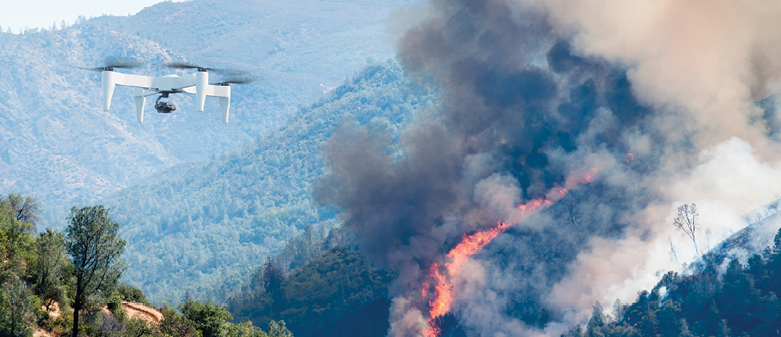
Solar-Powered Unmanned Airships
Instead of incorporating batteries into the airframes of drones as Impossible has done, Mothership Aeronautics in South San Francisco, is helping keep its unmanned aircraft in the sky using solar power and helium gas. Each airship generates more power from its solar panels than is needed to propel it.
“By combining solar photovoltaics with lighter-than-air lifting, we are creating a pathway for mankind and our robots to achieve aerial permanence,” said Jonathan Nutzati, founder and CEO of Mothership.
Mothership’s proof-of-concept unmanned aircraft, the Scout, is a 7-meter-long airship filled with roughly 300 cubic feet of helium and powered by 400 watts of solar power cells. Developed within three months of the company’s inception, the Scout has a top speed of 20 knots, a cruise speed of 12 knots, and is rated to carry 5 kilograms of payload.
Each airship has enough energy to fly for the sunlit portion of the day plus an extra 90 minutes using its reserve lithium-polymer batteries. They also can be configured to fly at night by replacing their solar power modules with battery modules, which currently can give them up to three hours of flight time in the dark, Nutzati said.
The company uses monocrystalline silicon-based photovoltaic cells for solar power. Although thin-film photovoltaic cells that companies such as Lockheed Martin and others use in their solar-powered high-altitude long-endurance aircraft are eight times lighter than the ones Mothership is using, “their solar cells cost about $40,000 for 400 watts while our solution costs about $200, not including labor, and the amount of watts per square meter is exactly the same,” Nutzati said.
Unmanned airships not only have great endurance, but Nutzati noted they are extremely safe. “Not only are there no humans onboard to get injured in the event of a crash, but also the airship is unable to free-fall, acting as a parachute for itself,” he said. “Impacts are soft and cushioned and the internal gas is inert. It is the safest aircraft you can possibly crash.”
Nutzati, an aerospace engineer, founded Mothership in 2016. He became interested in the applications of solar power while working at Tesla Motors, when he converted a motorhome to run on solar in the company parking lot.
“The CEO of Impossible Aerospace actually sold me that RV after he had lived in the Tesla parking lot—it’s a small world,” Nutzati recalled. “I was having eggs Benedict with a friend at a diner after a test flight of his electric motorized hang glider, and I was dreaming about what to do with the surplus of energy I had because of solar panels. I was struggling to find places to park my solar-powered RV, and so I dreamed about what would happen if the RV could float above the parking lot—then others could not get me to move it.”
TerraSoar and Sentinel
Originally, the company envisioned offering the Scout for precision survey applications such as pipeline inspections. However, “sadly, we learned in the field that the dynamics of an airship did not lend well to precision photogrammetry,” Nutzati said.
Whenever the wind blew on the Scout, it would rotate to align itself with the wind. “If you are trying to take a photo of specific GPS coordinates, you do not want your camera to move,” Nutzati said. “We had invested a lot of resources into using our airship for this application, only to find that the pictures it took were all over the place and terrible. It was an early moment of heartbreak for the company.”
The company went back to the drawing board. “We decided we would need a new type of hybrid airship never seen before to tackle this problem,” Nutzati said.
Mothership named the new airship it designed the TerraSoar, after the prehistoric flying reptiles known as pterosaurs, the first vertebrates to take to the air. Whereas the Scout places its motors about halfway down its body, the TerraSoar uses a series of trusses to keep its motors suspended near its nose. This shifts the center of mass, the center of thrust and the aerodynamic center of the aircraft in such a way that even if the wind causes its helium-filled envelope to swing around, the motors can stay in the same position.
“Imagine a horse pulling a chariot; TerraSoar is like a drone pulling a blimp,” Nutzati said. “It is a hybrid aircraft that, like a drone, can position itself very accurately, but also has a very long flight time supplemented by helium lift and solar power. It is like a car pulling a trailer full of gasoline. Nobody has done anything like it before.”
The company also offers a larger version of the Scout called the Sentinel. The Sentinel is more efficient in forward cruising than the TerraSoar and can reach higher top speeds. The TerraSoar is more efficient in hovering than the Sentinel, can hold position more precisely and can easily hover in any condition.
Both the TerraSoar and Sentinel come in models ranging 8 to 12 meters long that can have up to a kilowatt of solar panels and carry up to 10 kilograms of payload. They can both fly at speeds up to 40 knots, although their cruise speed is about the same as the Scout to optimize data collection capacities, Nutzati said. They are also both capable of GPS-directed autonomous flight.
Whereas the Scout is typically equipped with a gyro-stabilized pan-tilt GoPro optical camera or a MAPIR survey camera, the TerraSoar and Sentinel can carry a wider range of payloads such as a zoom camera, low-light camera, thermal camera, LiDAR and radar.
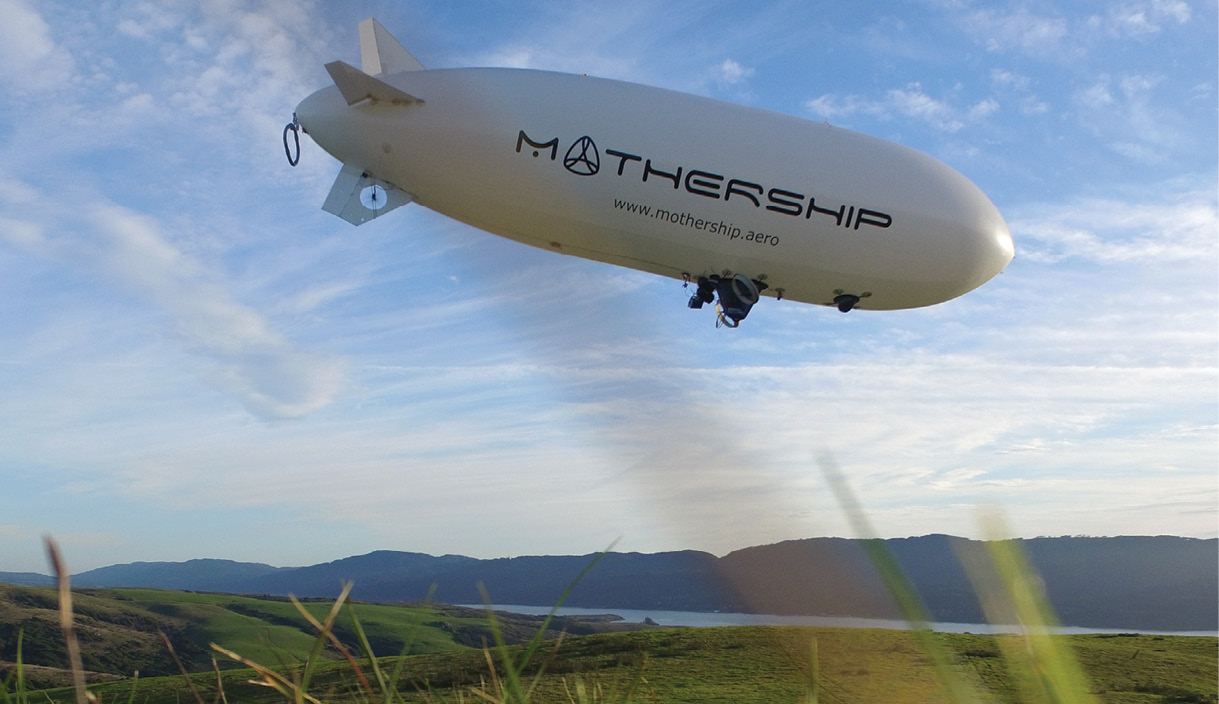
Applications for Airships
One key application that Mothership sees for the TerraSoar is aerial inspection of pipelines. “There are currently 2.5 million miles of operational energy pipeline in the United States,” Nutzati said. Currently inspections are typically performed by low-flying manned aircraft “at an annual cost of $15,000 per mile,” he noted. “Forty percent of the United States’ energy pipeline was built before World War II and needs to be inspected frequently to prevent disastrous spills.”
“The market for pipeline inspection is $37 billion in the United States alone, and there are related markets such as highway inspection, railroad inspection and water infrastructure inspection, which are also huge,” Nutzati said. “Inspection with the TerraSoar will bring reduced costs, improved safety and a higher actionability and quality of data.”
“Drones have been slow to break into the pipeline inspection business due to their short range and flight times and FAA visibility requirements,” Nutzati continued. “Currently, the FAA limits operations of unmanned aerial vehicles to within line-of-sight of the operator. At 8 to 12 meters length, TerraSoar can be seen at over 10 times the distance of the largest inspection drones on the market…line of sight operations for us can easily reach 5 kilometers.”
Mothership was working on an FAA Beyond Visual Line of Sight (BVLOS) waiver, but “we have paused this because we have found substantial interest in markets where such regulations are not as restrictive,” Nutzati said. “We felt directing our resources at U.S. BVLOS wouldn’t be most effective, given that there are people in the U.S. with deeper pockets already paving the way for us.”
Another possible application for the airships is in mineral discovery for mining. Nutzati noted a mining exploration company working in Brazil was paid $500 million to hang a magnetic sensor from a helicopter to look for gold over 500 square kilometers of jungle. “I heard that and thought, ‘Wow, that would be an awesome application for our aircraft, and there is definitely money in it,’” he said.
Whereas drones cannot fly with a magnetic sensor for as long as needed for this application, and helicopters are expensive, “our airships are exactly what are needed to help prospect and find resources with precision,” Nutzati said. “Moreover, the sensors are more sensitive and can be smaller when they are flown closer to the ground, and our airships can get close to the ground.” (The airships can fly at altitudes of 400 to 800 feet, depending on atmospheric conditions.)
The company also offers its airships for security applications. “China has its One Belt One Road program, where it will connect itself with Western Europe by rail for the first time in history, and also by sea with the eastern coast of central Africa,” Nutzati said. “This is a massive infrastructural undertaking through a lot of unstable regions, where the potential for vandalism or sabotage is high. We could imagine airships patrolling and inspecting from China to Western Europe. We’re talking about a market in the trillions.”
The airships can be configured for stealth, “such that they are not visible from the ground at night, and we have designed propellers that can be very quiet so that cannot be heard from the ground,” Nutzati said. “There are also operational methodologies we can use to make sure we approach a scene without being detected.
Mothership can also make its airships far more visible and audible. “When we went to the Philippines to find out how we could help out after typhoons, I proposed an airship with a megaphone and an LED display on its sides,” Nutzati said. “You could fly it to a village, make noise on the megaphone, have it say, ‘Hello people—if you are alive, come out of your homes,’ and the camera could see if anyone is there. You could then display instructions on the LED screen, such as tuning in to a radio frequency for communications, and then drop packages from the airship such as small amounts of food, water, medicine and walkie-talkies.”
Nutzati cautioned that the airships “are not as quick to deploy as a DJI Phantom or other quadcopters. It requires a larger, more clear landing and takeoff pad than a drone would due to its size, and a substantial supply of helium.”
The Future of Mothership
After an initial $25,000 investment from Boost VC in San Mateo, California, Mothership raised a seed round of $1.45 million to build and deploy TerraSoar, which officially launched in September. The price of its Scout starts at $30,000, while its Sentinel and TerraSoar sell for upward of $150,000 fully loaded, Nutzati said. The Scout is available now, while deliveries of the Sentinel and TerraSoar are scheduled to begin at the end of 2018.
So far Mothership has had two major customers commit to buying aircraft, with one client pledged to buying 10 airships in 2019, Nutzati said. Although these customers have asked to remain anonymous at this time, they are government agencies and infrastructure stakeholders, he noted.
Although helium supplies can undergo shortages, “as of right now, it is plentiful enough for what we are doing,” Nutzati said. “In the long term, it is not too difficult for us to employ hydrogen or heated air to replace helium.”
Within the next six months, “we want an airship that can go 24 hours—that can take off in the morning and then come back the next morning,” Nutzati said. “There are companies at the InterDrone conference that sell hydrogen fuel cells that we suspect could easily fit into the Sentinel to allow it to fly seamlessly through the day and night. What that will allow us to do is to cover larger distances autonomously and patrol long borders.”
In the future, Mothership plans to live up to its name with airships that can serve as drone carriers. “That was the original idea behind Mothership,” Nutzati said. “I was a big player of the game Starcraft, in which a species known as the Protoss have a carrier unit, a flying aircraft carrier, one of the most powerful air units you can build, which carries smaller aircraft that launch out to attack targets, return to the mothership carrier to recharge, and then fly back out again. I thought it would be great if we could recreate this not for war, but with a solar-powered airship for aerial robots.”
“We can imagine creating mesh networks of airships and drones for energy pipeline inspection,” Nutzati said. “Photogrammetric inspection of pipelines requires photos to be taken directly over the centerline, and on each side of the right of way, which can be up to 50 feet laterally from the centerline. In order for a single aircraft to get all of these photos, it would have to maneuver in a zigzag or s-type pattern, which would greatly decrease the amount of pipeline that can be inspected in a single day. Launching smaller drones from the mothership allows for the photos to be captured on either side of the right of way concurrently. Additionally, should an anomaly or item of interest be discovered, one of the smaller drones could dive in for a closer look or get a different angle to ensure that it is properly documented.”
Drone carriers also could find use “in very large farms, ones big enough to require a truck to drive from one side of a field to the other,” Nutzati said. “You need a lot of robots to perform a lot of tasks over large areas on these farms, and drone swarms could be docked on and deployed from a mothership.”
Another application “could be offshore wind turbines,” Nutzati said. “A good way to inspect wind turbines is with a drone, but they can be 20 miles offshore. An airship is by itself too big to safely get close enough to the blades for inspections, but it can go to a wind farm and then dispatch drones.”
Nutzati dreams the surplus of energy from solar-powered airships could help recharge flying cars, just as Tesla’s Supercharger network helps its electric cars recharge on the ground. “The most energy aircraft spend is flying up in altitude,” he said. “Instead of having flying cars wasting energy going down and up every time they need to charge their batteries, motherships could help them recharge in the air.”
“We’re clearly seeing a tremendous drive for technological innovations to enable longer flight times with miniature systems like Impossible Aerospace’s and solar-powered high-altitude long-endurance or HALE systems, as more endurance is a real competitive edge,” Finnegan said. “I think inevitably other drone manufacturers are going to try and develop similar sorts of technology to blunt this competitive edge.”
Firms are now working on a drone that can fly two hours on a single charge, and a solar-powered airship that could someday carry drones.



